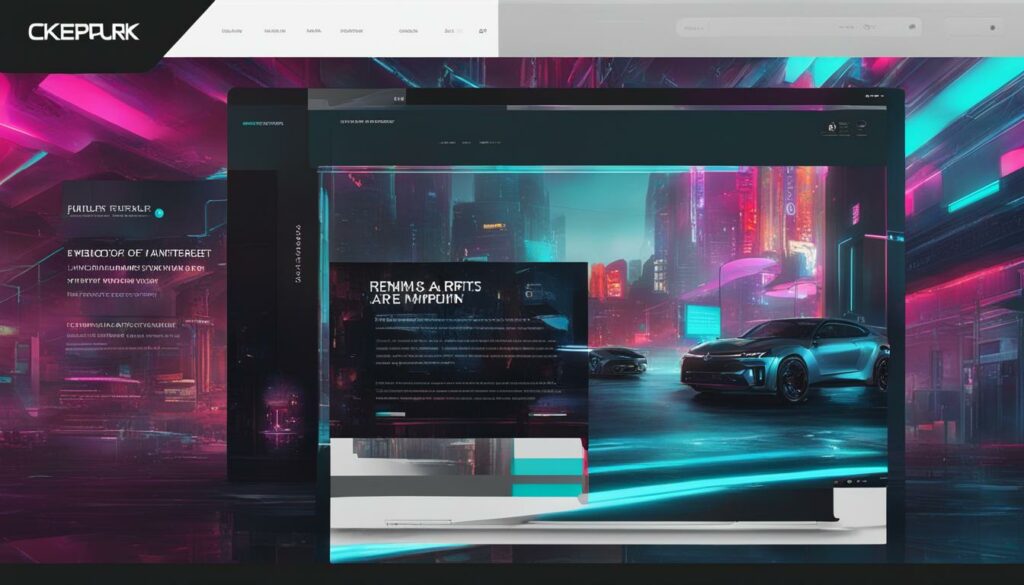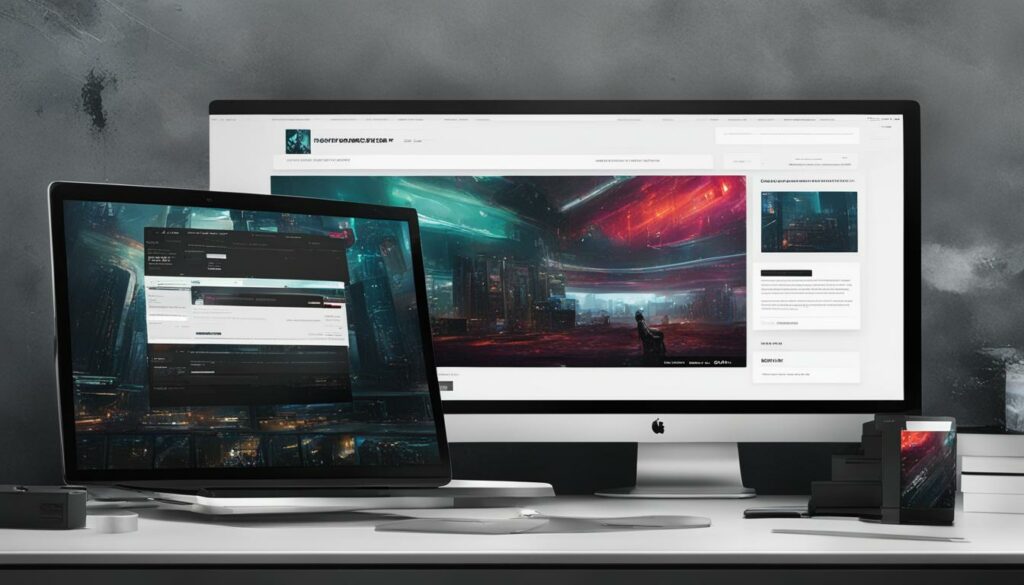Hosting an open studio event can be a valuable opportunity for artists to showcase their work, connect with their community, and potentially make sales. But the success of such an event depends on careful planning and execution. In this article, we’ll explore key insights and best practices for hosting artists and galleries, covering topics such as website hosting, website design, and more.
Key Takeaways:
- Define goals and tailor your approach based on intentions and audience.
- Consider alternative options like virtual open studios or partnering with other artists.
- Send personalized and timely invitations to ensure maximum attendance.
- Prepare your studio space and provide clear signage for easy navigation.
- Stay engaged and prioritize quality exchanges with attendees.
The Importance of a Website for Artists
In the digital age, having a website is essential for artists to market their work, build a brand, and sell their artwork, products, and services. A website allows artists to showcase their unique style, stand out from the crowd, and reach a wider audience.
Social media platforms are helpful for promotion, but they should not replace having a personal website. While platforms like Instagram and Facebook can provide exposure, they are not customizable and restrict artists to the platform’s design limitations. Having your own website gives you complete control over its appearance and optimization.
Free website builders may be tempting, but they often lack customization options, control over design, and search engine optimization (SEO) capabilities. By investing in a professional website, artists can tailor the design to their brand, optimize their content for search engines, and ensure their work is discoverable by a larger audience.
Having a dedicated website also adds credibility to your artistic practice. It shows potential buyers and collectors that you are serious about your craft and committed to showcasing your work in a professional manner.
A well-designed website can serve as a hub for your artistic portfolio, allowing visitors to explore your artwork, learn about your creative process, and engage with your brand. It is an opportunity to tell your story, share your artistic journey, and connect with art enthusiasts who resonate with your work.
Additionally, a website provides a centralized platform for potential buyers to view and purchase your artwork. With an online store integrated into your website, you can streamline the sales process, offering a convenient and secure way for art lovers to support your artistic career.
Remember that a website is an ongoing project. Regularly updating your website with new artwork, blog posts, exhibitions, and events will keep visitors engaged and encourage them to return for future updates.
Investing in a professional website is a crucial step for artists looking to establish their online presence, expand their reach, and cultivate a following of loyal supporters. With a well-designed and optimized website, you can showcase your artwork to the world and turn your passion into a sustainable career.
Key Benefits of Having a Website:
- Showcase your unique style and artwork
- Reach a wider audience and expand your potential market
- Establish credibility and professionalism
- Have total control over design and optimization
- Create a centralized hub for your artistic portfolio
- Sell your artwork directly from your website
- Engage with art enthusiasts and build a loyal following
- Update your website regularly to keep visitors engaged
Choosing the Right Website Builder for Artists
When it comes to building a website for your art, selecting the right website builder is crucial. You need a platform that offers the right features to showcase your artwork effectively, while also being user-friendly and affordable. Here are some factors to consider when choosing a website builder:
Design Options and Customization Capabilities
A visually appealing website is essential for artists to showcase their unique style. Look for a website builder that offers a wide range of design templates and customization options to create a site that truly reflects your artistic vision.
User-Friendliness
As an artist, you want to focus on creating and promoting your artwork, not struggling with complex website-building tools. Choose a website builder that is intuitive and easy to use, allowing you to update your site and make changes effortlessly.
Search Engine Optimization Features
Optimizing your website for search engines is essential to ensure that your artwork is discoverable by a larger audience. Look for a website builder that offers built-in SEO features, such as customizable meta tags, clean URLs, and image optimization.
Pricing
Affordability is an important consideration for artists, especially those who are just starting out. Compare the pricing plans of different website builders to find one that fits within your budget while still offering the features you need.
Popular website builders that are well-suited for artists include:
| Website Builder | Design Options | Customization Capabilities | User-Friendliness | SEO Features | Pricing |
|---|---|---|---|---|---|
| Squarespace | Professionally designed templates | Limited customization | User-friendly interface | Built-in SEO features | Pricing plans ranging from $12 to $40 per month* |
| Wix | Wide range of design templates | Flexible customization options | Drag-and-drop editor | SEO-friendly features | Pricing plans ranging from $14 to $39 per month* |
| Weebly | Stylish and responsive templates | Easy customization options | Intuitive website editor | SEO optimization tools | Pricing plans ranging from $6 to $26 per month* |
| Blogger | Simple and minimalist templates | Basic customization options | User-friendly interface | Built-in SEO features | Free platform with the option to use a custom domain* |
| WordPress | Thousands of customizable themes | Extensive customization capabilities | Suitable for both beginners and advanced users | Plugin options for SEO optimization | Free to start, with premium plans starting at $4 per month* |
Consider the features offered by each website builder and choose the one that best aligns with your artistic goals and requirements. Remember to prioritize platforms that allow you to showcase beautiful and accurate photography and videos of your artwork, enable price transparency, and support the development of a mailing list. Additionally, hiring a writer to craft catalogue essays and hosting private studio salons for potential buyers and VIPs can elevate your online presence and boost your art sales.
*Prices are subject to change and may vary based on additional features and subscription plans.
Importance of Photography and Videos for Art Sales
When it comes to selling art online, high-quality photography and videos are crucial. These visual mediums allow potential buyers to experience and connect with your artwork in a way that words alone cannot convey. By capturing the beauty and essence of your pieces through stunning visuals, you can effectively attract and engage art enthusiasts. Here’s why photography and videos are essential for the success of your online art sales:
1. Showcasing Your Artwork in its Best Light
Beautiful and accurate photographs are essential for presenting your artwork in the best possible way. By capturing the details, textures, and colors of your pieces, you can evoke an emotional response from viewers. Proper lighting, color correction, and high resolution are key factors in ensuring that your artwork is accurately represented online.
2. Documenting 3D Pieces and Complicated Installations
While photographs are excellent for showcasing 2D artwork, videos are especially beneficial for documenting 3D pieces or complicated installations. Videos provide a dynamic experience that allows potential buyers to fully comprehend the scale, movement, and intricacies of your artwork. This immersive experience can enhance their understanding and appreciation of your work.
3. Telling a Compelling Story
Photography and videos can be powerful storytelling tools. By carefully curating and presenting your artwork in these visual formats, you can create a narrative that inspires and captivates viewers. Use photographs and videos to showcase your creative process, behind-the-scenes moments, and the emotions that drive your artistic expression. This storytelling approach can deepen the connection between your audience and your artwork.
To ensure the best possible results, it is recommended to outsource photography and videography to professionals who specialize in capturing artwork. They have the expertise and equipment necessary to effectively showcase your pieces and create visually stunning content.

Having high-quality photography and videos on your artist website and social media platforms is crucial for attracting potential buyers and creating a memorable online presence. These visual assets allow art enthusiasts to fully experience your artwork and connect with it on a deeper level. By investing in professional photography and videography, you can elevate your art sales and establish yourself as a reputable and sought-after artist.
Price Transparency and Publishing Artwork Prices
Price transparency is crucial in the art world, and as an artist, you need to provide potential buyers with the information they’re looking for. More and more buyers prefer to see prices listed online, as it helps them make informed decisions and saves time by mitigating expectations. By establishing trust through price transparency, you can attract serious buyers and create a sense of confidence in your work.
When designing your website, consider including a dedicated section where you publish the prices of your artwork. This allows visitors to browse your portfolio and immediately understand the cost associated with each piece. By providing clear and transparent pricing, you eliminate ambiguity and create a more straightforward buying process. Not only does this attract buyers who appreciate transparency, but it also saves you time by reducing inquiries about pricing.
Pricing your artwork consistently is another essential aspect of running a sustainable art business. Price discrepancies can confuse potential buyers and create the impression that the value of your work is uncertain. By establishing clear and consistent pricing guidelines, you demonstrate professionalism and foster trust in your brand.
When displaying prices on your website, consider categorizing your artwork based on size, medium, or series. This makes it easier for buyers to navigate and find the specific pieces they are interested in. You may also want to provide additional information, such as the inspiration behind the artwork or any unique details that contribute to its value.
Remember, showcasing your prices doesn’t mean you have to sacrifice the exclusivity or value of your work. Make sure to present your prices in a way that aligns with the overall aesthetic and tone of your website, reinforcing the quality and craftsmanship of your artwork.
Now that you understand the importance of price transparency and publishing artwork prices on your website, let’s move on to the next section where we explore the significance of building a mailing list and self-publishing catalogues.
Building a Mailing List and Self-Publishing Catalogues
As an artist, building a mailing list is essential for cultivating relationships, promoting your work, and staying connected with potential buyers. Networking and attending events provide valuable opportunities to expand your network and gain new contacts.
Once you’ve established your mailing list, regularly sending out newsletters is a great way to keep your audience informed and engaged. These newsletters should include beautiful images of your new artworks, links to your social media profiles, and clear calls to action. By consistently sharing updates and insights, you can build excitement around your work and encourage your subscribers to take action.
Segmenting your mailing list based on various categories is a smart strategy. Creating separate groups for press contacts, dealer contacts, VIP collectors, and curators allows you to tailor your messages and content to specific audiences. This targeted approach ensures that your communication is relevant and personalized, increasing the chances of generating interest and sales.
“Building a mailing list is like nurturing a garden – with proper care and attention, it will flourish and bear fruit.”
In addition to a mailing list, self-publishing catalogues can be a powerful marketing tool for artists. These catalogues showcase your work in a polished and professional manner, providing potential buyers with a comprehensive view of your artistic style and achievements.
When self-publishing a catalogue, consider including a biography and CV to give your audience a deeper understanding of your artistic journey and accomplishments. Hiring a writer to draft a compelling catalogue essay can add an extra layer of depth and meaning to your work, allowing viewers to connect with your art on a more profound level.
Benefits of Building a Mailing List and Self-Publishing Catalogues
A mailing list and self-published catalogues bring numerous benefits to artists:
- Direct communication with a targeted audience, allowing you to share updates, exhibition announcements, and promotional offers.
- A chance to showcase your artwork in a professional, curated format.
- Opportunities to engage with collectors, curators, and other industry professionals.
- The ability to stay top-of-mind with potential buyers, increasing the likelihood of sales and commissions.
- A platform for storytelling and expressing your artistic vision beyond individual pieces.

| Building a Mailing List | Self-Publishing Catalogues |
|---|---|
| Connect with potential buyers | Showcase work professionally |
| Targeted communication | Curated representation of artwork |
| Keep subscribers informed | Enhance depth and meaning |
| Promote exhibitions and offers | Engage with collectors and curators |
| Stay top-of-mind with buyers | Tell a compelling artistic story |
By building a mailing list and self-publishing catalogues, artists have the opportunity to expand their reach, strengthen connections, and present their work in a memorable and professional manner. These strategies empower artists to effectively market their art, engage their audience, and ultimately increase their art sales.
Conclusion
Selling art can be an art form in itself, and as an artist, it’s important to adopt a mindset of “always be closing” to drive sales and create a sustainable art business. To effectively market your work and connect with your audience, there are several best practices to consider.
First, take advantage of the digital landscape by showcasing your work on a professional website. Utilize high-quality photography and videos to captivate potential buyers and tell a compelling story about your artwork. By investing in reliable website hosting services, you can ensure your website is accessible and functional.
Transparency is key in the art world, so consider publishing your artwork prices on your website. This establishes trust with potential buyers and saves both parties valuable time. Additionally, building a mailing list allows you to cultivate relationships, promote your work, and stay connected with interested buyers. Sending out regular newsletters and subdividing your list into specific categories ensures personalized and effective communication.
Lastly, consider self-publishing catalogues to showcase your work in a professional and polished manner. Include a biography, CV, and a well-crafted catalogue essay to enhance the overall presentation. Hosting private studio salons can also provide exclusive experiences for potential buyers and VIPs, further building personal connections and increasing the likelihood of sales.
By following these best practices, you can effectively market your work, connect with your audience, and increase art sales. Remember, selling art is not just about the artwork itself, but also about creating a memorable experience for your buyers.
FAQ
Q: What are the benefits of hosting an open studio event?
A: Hosting an open studio event allows artists to showcase their work, connect with their community, and potentially make sales.
Q: How should I prepare for an open studio event?
A: It is important to define the goals for the event, send out personalized invitations, update inventory, ensure clear prices are established, create an inviting physical studio space, and provide proper signage.
Q: Is having a website important for artists?
A: Yes, having a website is essential for artists to market their work, build a brand, and sell their artwork, products, and services.
Q: What should I consider when choosing a website builder?
A: Factors to consider when choosing a website builder include design options, customization capabilities, user-friendliness, search engine optimization features, and pricing. Popular options include Squarespace, Wix, Weebly, Blogger, and WordPress.
Q: Why are photography and videos important for art sales?
A: High-quality photography and videos are crucial for showcasing artwork online, attracting potential buyers, and telling a compelling story about the artwork. Professional photography and videography are recommended for optimal results.
Q: Should I publish artwork prices on my website?
A: Yes, price transparency is important in the art world. Publishing artwork prices on your website establishes trust with potential buyers and saves time by managing expectations.
Q: Why is building a mailing list important for artists?
A: Building a mailing list allows artists to cultivate relationships, promote their work, and stay connected with potential buyers. Sending out regular newsletters with captivating images, social media links, and calls to action is key.
Q: Should I self-publish catalogues?
A: Yes, self-publishing catalogues can serve as sales tools, demonstrate professionalism, and showcase your work. Hiring a writer to draft a catalogue essay can add polish and sophistication to your catalogues.
Q: How can I increase art sales?
A: To increase art sales, artists should take advantage of the digital landscape, showcase their work online, engage with potential buyers, utilize professional photography and videos, publish artwork prices, build a mailing list, self-publish catalogues, and host private studio salons.












